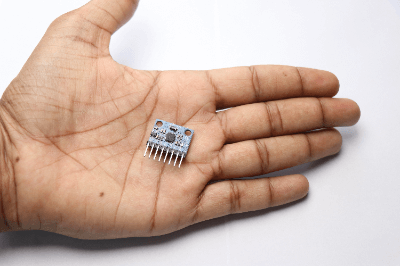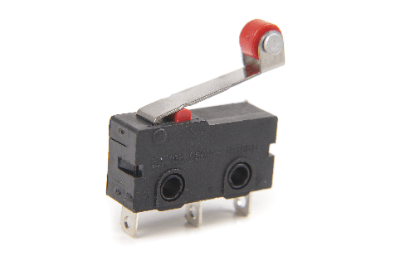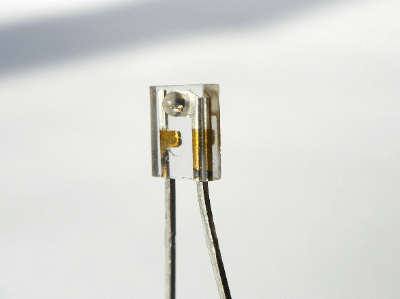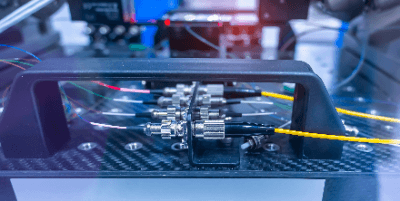What Is a Gyroscopic (Gyro) Sensor?
 A gyroscopic (gyro) sensor is a sensor used to detect angular velocity.
A gyroscopic (gyro) sensor is a sensor used to detect angular velocity.
It is also called a gyroscope. Angular velocity refers to the physical quantity of rotation of an object per unit of time, and is an indispensable sensor in today’s industrial machinery products, where advanced and accurate control is required.
Gyro sensors are heavily used in fields such as robotics, aircraft, and automobile body control, where feedback control must take into account minute rotations.
Uses of Gyroscopic Sensors
Gyro sensors are used in a wide range of applications in the control of smartphones, digital cameras, gaming devices, space industry, aviation, automobiles, and industrial robots.
Specific applications of gyro sensors are as follows:
- Image stabilization of smartphones and digital cameras
- Walking control of biped robots
- Measurement and control of aircraft position
- Measurement of user movement and position in VR games
Gyro sensors have different characteristics depending on the product, such as size and heat and vibration tolerance. Therefore, the accuracy of the control of the device using the gyro sensor and the environment in which it will be used must be taken into consideration when selecting a gyro sensor.
Principle of Gyroscopic Sensors
Gyro sensors are typically classified into the vibration type, which functions according to the Coriolis force, and the optical type, which functions according to the Sagnac effect of light.
1. Vibrating Gyroscopic Sensor
The Coriolis force used in vibrating gyro sensors is the fictitious force acting on an object located in a rotating frame of reference with respect to an inertial frame.
Vibration gyro sensors can be further classified into piezoelectric and capacitive types.
- Piezoelectric Method
This method measures the voltage value generated in a rotating transducer as a physical quantity corresponding to the Coriolis force.
- Capacitance Method
The Coriolis force during rotation generates a difference in the capacitance between the left and right sensing electrodes of the resonator, and the angular velocity is calculated by measuring the Coriolis force from the difference in capacitance.
The relationship between the Coriolis force and angular velocity can be expressed by the following equation.
ω=F/2mv (ω: angular velocity, F: Coriolis force, m: mass of object, v: velocity of movement)
2. Optical Gyroscopic Sensor
The Sagnac effect used in optical gyroscopic sensors is the principle stating that if the optical path through which light passes is in motion, the length of the optical path will increase. This physical phenomenon occurs because the speed of light is always constant. In an optical gyroscopic sensor, the light path lengthens as the orbiting light itself rotates, and the angular velocity can be calculated by measuring the phase difference caused by the lengthening.
Other Information on Gyroscopic Sensors
1. Gyroscopic Sensor Compensation Methods
Drift Correction
There are multiple factors that can cause errors in the output of Gyroscopic (Gyro) Sensors. One of the most important such factors is drift, which refers to the drift of the zero point, which is originally given as the initial value, resulting in a gradual shift of the initial value and a larger detection error.
Internal factors that cause drift include DC component fluctuations (low-frequency fluctuations) and high-frequency noise effects; DC component fluctuations are called bias instability and high-frequency noise is called angular random walk. Bias instability depends on the stability of the supply voltage, which can be improved by reviewing the power supply.
Angular Random Walk Correction
The correction method for angular random walk is a matter of each company’s know-how, but a commonly used correction method is to use a Kalman filter.
The Kalman filter is a method for estimating the most appropriate system state based on the previous information and the currently acquired data. It can be rephrased as a problem of estimating the original state of a variable that changes with time, based on the past information and the currently acquired information. It is important to treat the measured values and the variables themselves as if they are subject to noise.
2. Difference Between a Gyroscopic Sensor and an Accelerometer
Gyroscopic sensors are similar to accelerometers. Although they are sometimes confused, they are completely different.
As the name suggests, acceleration sensors are designed to detect acceleration. They use inertial forces to measure changes in the speed at which an object is moving and outputs them as an electrical signal. Acceleration sensors are used in a wide range of applications because other types of information, such as the state of vibration of an object and the magnitude of impact, can also be obtained from acceleration. The basic structure is similar to that of a gyro sensor.
Gyros sensors, on the other hand, as mentioned above, are used to detect angular velocity. They use the Coriolis force to measure the motion (rotation) and changes in orientation and posture of an object and output them as electrical signals.
3. 3-, 6-, and 9-Axis Sensors
Recently, 3-axis and 6-axis sensors are often described as sensors that detect inertial force. Each corresponds to acceleration (3-axis) and angular velocity (6-axis) of forward/backward, left/right, and up/down, and as in-vehicle sensors, they are indispensable for ADAS and automatic driving technology, which are driving assistance systems for automobiles.
As an example, car navigation systems are equipped with both Gyroscopic (Gyro) Sensors and Acceleration Sensors. By using Gyroscopic (Gyro) Sensors to detect the direction of the car and Acceleration Sensors to detect the distance traveled, the current location can be displayed with high accuracy even in places where signal reception is difficult, such as inside a tunnel.
The three axes are represented by roll, pitch, and yaw, and these axes can be used to represent posture. Especially for roll and pitch, it is possible to compensate for the drift, which is a source of error, as a feedback circuit. Furthermore, as a different ref for drift correction, there is a current standard that uses a magnetometer sensor in addition to the 6-axis compatible sensor, in which case it is called a 9-axis compatible sensor.
4. MEMS Compatibility With a Gyroscopic Sensor
Gyro sensors are used to display and control the motion of rotating machinery. MEMS technology is used in the semiconductor industry, where it is based on thin-film microfabrication technology.
Gyroscopic sensors also differ from optical and mechanical sensors in that they are relatively easy to miniaturize and integrate, and because MEMS sensors are highly compatible with ASICs that enable relatively sophisticated control, they are built into many devices, including smartphones and other mobile devices.
Furthermore, gyro sensors have different detection ranges for angular velocity, depending on their application. For example, mobile devices such as smartphones require a range of 300 to 2000 DPS (degrees per second, rotation angle per second), while automotive devices such as car navigation systems require a range of 100 to 500 DPS.
Therefore, when selecting a sensor, one must consider how much detection range is sufficient based on the usage conditions of the device.

 A gyroscopic (gyro) sensor is a sensor used to detect angular velocity.
A gyroscopic (gyro) sensor is a sensor used to detect angular velocity.
 A fiber optic sensor is an optical
A fiber optic sensor is an optical